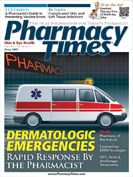Publication
Article
Pharmacy Times
Safe Sharp Device Disposal: Challenges
Author(s):
Pharmacists may be affected by future changes in regulations surrounding the disposal of sharps devices.
Tom Erickson, chief executive offier of UltiMed, Inc
As the chief executive officer of a company that manufactures insulin syringes and pen needles for the United States and Canadian markets, I have been monitoring the regulations and trends pertaining to the safe disposal of the products we produce. It’s safe to assume that there may be significant changes in the United States related to the disposal method of used sharps devices—and it’s likely that pharmacists will be affected by these future changes.
Surveys indicate that less than 5% of the more than 3 billon sharps devices sold in the United States annually are disposed of in some type of closed container. Of the remaining 95%, most are deposited—unprotected— into the household trash.
The most influential group promoting safe sharps disposal regulations are the companies that handle household trash. These waste companies report that they incur millions of dollars in expenses annually caused by their workers being accidentally stuck with used needles. They claim that each needle stick creates more than $3000 in testing and sick leave expenses for their employees, plus some needle sticks cause serious illness. The incidence of needle stick injuries has risen with the increased use of sorting lines at transfer stations where workers hand sort waste as it rapidly moves down conveyer belts before the remaining waste goes to a landfill. These workers wear protective gloves, but the incidence of needle stick injuries is still very high. Because of this problem, waste companies have been lobbying intensely to remove used sharps devices from the household waste stream.
Pressure is also coming from another direction. The world’s environmental movement has been actively involved in promoting the safe disposal of hazardous products. A growing number of countries enacted rules regulating the disposal of home-generated waste including batteries, electronics, tires, paint, and pharmaceuticals. The safe disposal of medical sharps devices, such as syringes and pen needles, is also included in this effort and a growing number of countries have enacted regulations pertaining to homegenerated sharps waste.
There are 2 generally accepted ways to transport used needles to a collection point:
- The user returns the needles in an approved sharps container to an authorized collection point (sometimes a pharmacy or hospital).
- The user mails the needles to the collection point, called “mail-back.” Due to postal regulations and much higher expense, the mail-back option is rarely used.
Many of the hazardous waste disposal regulations used around the world incorporate the concept of “Extended Producer Responsibility” (EPR). Also called “Product Stewardship,” EPR uses financial incentives which encourage manufacturers to design environment-ally friendly products by holding producers liable for the costs of managing their products at end of life. The purpose of EPR is to relieve governments of the costs of managing hazardous waste. EPR promotes producers having the greatest control over product design and marketing, and therefore having the greatest ability and responsibility for end of life.
The United States currently has no national laws pertaining to the safe disposal of sharps waste. However, the EPA has published new guidelines for the disposal of home-generated sharps waste, the purpose of which is to encourage the removal of sharps waste from the normal household waste stream. The EPA recommends 6 disposal options. The use of sharps containers is implicit in all 6 methods recommended by the EPA.
Many states and localities are attempting to adapt to the EPA guidelines, with little success to this point. Some states now require the storage and transport of used syringes and pen needles in sharps containers. An example of this type of legislation is California’s SB 1305, which was passed in July 2006. However, the effect of SB 1305 has been negligible.
Why was California’s SB 1305 ineffective? Industry observers believe it’s because the California legislation omits the 2 most critical components of the world’s most successful programs that have high compliance rates. These critical components are 1) free sharps containers and 2) convenient authorized collection points.
There are some examples of successful sharps waste collection programs in the United States. Two of the most cited examples are in Sioux Falls, South Dakota, and San Luis Obispo, California. Both incorporate the 2 critical components mentioned above. A large part of the funding for these programs comes from their local governments.
Another form of funding is for the pharmacies to pay for disposal of home use sharps. Canada is an example where pharmacies sometimes pay the cost. Pharmacy payment in Canada started when some pharmacies tried to get a competitive edge attracting diabetic customers by offering free sharps containers and disposal. When other pharmacies in Canada realized they were losing their valued diabetic customers to this tactic, they countered with their own programs. It’s noteworthy that some provinces in Canada are considering legislation to move to an EPR model, which would transfer the cost from pharmacies to the sharps manufacturers.
The next few years will be interesting as political pressure and EPA guidelines move the 50 states to enact home use sharps collection legislation. It’s easy to predict what the most controversial issue with this new legislation will be—who is going the pay the bill? There are 3 alternatives:
- The Canadian model, where pharmacies pay the cost.
- The Sioux Falls and San Luis Obispo models, where government pays.
- The EPR model, where the sharps manufacturers pay for the safe disposal of their products.
It will be interesting to see which of the 3 options the 50 state legislatures take.
Tom Erickson is chief executive officer of UltiMed, Inc which is located in St. Paul, Minnesota.







